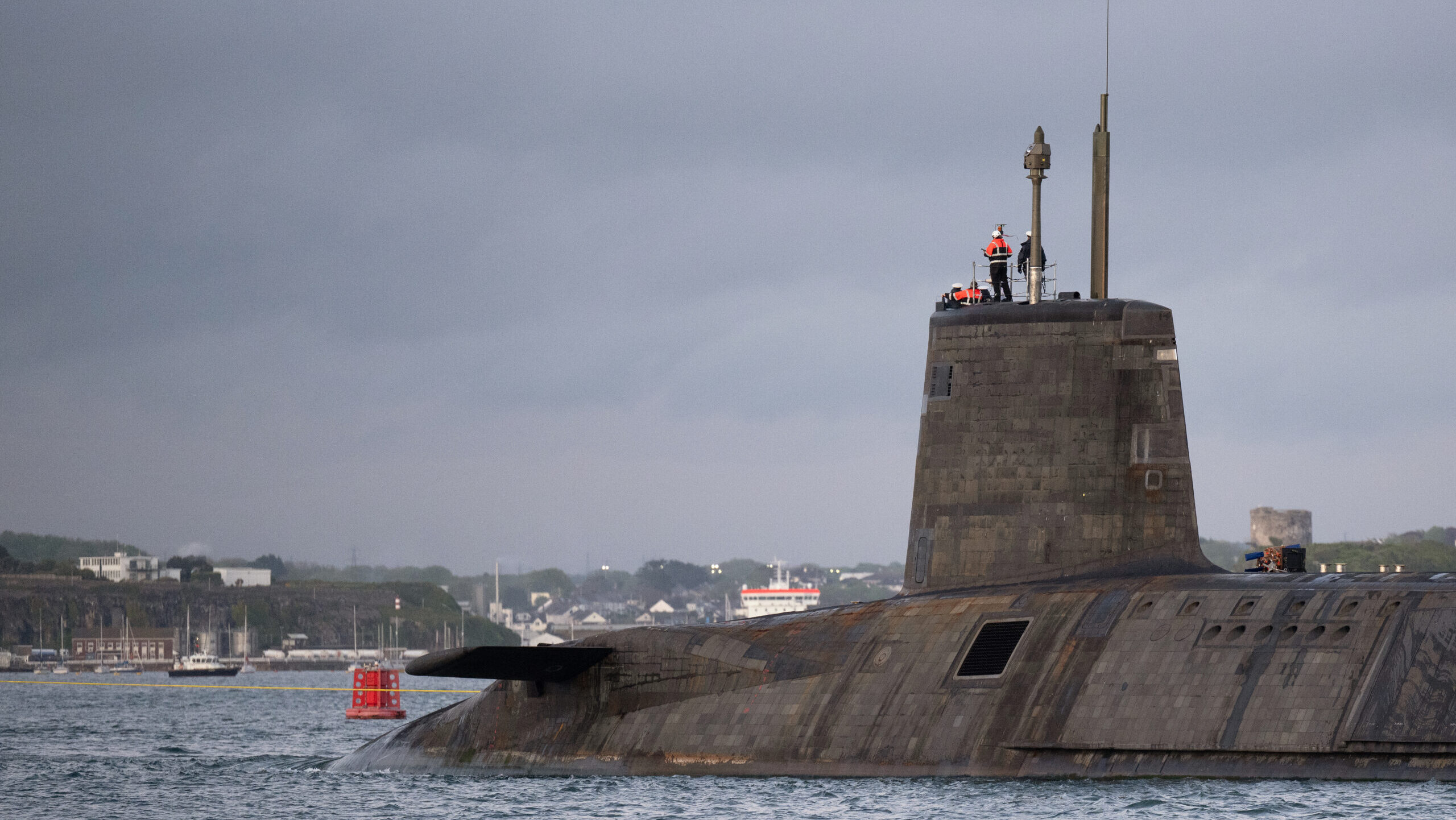
The Royal Navy’s HMS Vanguard nuclear powered ballistic missile submarine leaves Devonport naval base, England, after a seven and a half year refit. (UK MoD)
BELFAST — A British Trident II D5 unarmed nuclear missile that fell into the Atlantic Ocean shortly after failing to launch properly from a Royal Navy submarine suffered “an anomaly,” according to UK Defence Secretary Grant Shapps.
The embarrassing incident, marking the second successive Royal Navy Trident launch test failure in eight years, was first reported by The Sun, which linked the cause of the misfire to first stage rocket boosters not igniting. The long interval between test fires on HMS Vanguard are a result of a more than seven year refit program.
As for the exact cause of the misfire, the UK Ministry of Defence (MoD) told Breaking Defense in a Wednesday statement that reports of Trident suffering a rocket boost failure were “not” correct, clearly pushing back on the Sun report. However, the MoD would not comment on the “specifics of the anomaly.”
Breaking Defense was also told that the MoD “wont comment on the specifics of investigations,” relating to the Trident incident but the test failure is considered a “concern” for both the Royal Navy and the UK Defence Nuclear Organisation, with the latter, in particular, continuing “to work closely with the US.”
Trident II D5 missiles, with a range of 4,000 nautical miles are deployed on board US Navy Ohio-class submarines and manufactured by Lockheed Martin.
The Sun also reported that the Trident test was supposed to travel 6,000 km before landing in the sea between Brazil and West Africa, but “crashed” into the Atlantic, “yards” away from the HMS Vanguard nuclear powered ballistic missile submarine (SSBN) after the misfire. Both Shapps and the Royal Navy’s UK First Sea Lord Ben Key, were on board HMS Vanguard at the time of the failed Trident test.
Shapps sought to down play any impact the test failure, which occurred while HMS Vanguard was at sea to conclude a deep maintenance cycle, will have on the credibility of the UK’s nuclear deterrence.
In a statement to Britain’s parliament today he said the “anomaly” was “event specific” and added that “there are no implications for the reliability of the wider Trident missile systems and stockpiles.”
He went further to suggest Britain’s “ability to fire our nuclear weapons” in wartime is not in any doubt, bolding claiming that Trident “remains the most reliable weapons system in the world,” courtesy of achieving 190 successful tests, which include US unarmed or dummy fires.
The UK does not typically comment on nuclear submarine activities, but Shapps said the “level of interest” on this occasion, called for “as much information as possible” to be made public, while protecting national security.
“The government has absolute confidence that the UK’s deterrent remains effective, dependable, and formidable,” Shapps said. “That is why we are continuing to invest in the next generation of Dreadnought Class ballistic missile submarines, in extending the life of the Trident missile and replacing the warhead, to keep us safe for decades to come.”
Despite such a resolute defense of Trident by Shapps, the latest misfire comes after a refit to HMS Vanguard that took over seven years, three longer than expected, and saw costs balloon to an estimated £500 million ($631 million).
The end of the sub’s maintenance period, under a standard Demonstration and Shakedown Operation (DASO), covering weapon systems, subsystem tests and crew performance, was planned so the vessel could re-enter service after the refit phase.
“The purpose of the DASO is to validate the submarine and its crew, including through a two-month period of exercising the submarine’s systems and its crew, culminating in the firing of a missile … So no [new test fire will be lined up] because the operation was successfully completed,” said a MoD spokesperson.
Lockheed Martin declined to comment on the Trident incident, instead referring Breaking Defense to the MoD.
The UK operates four Vanguard class ballistic missile submarines which maintain the UK’s Continuous At Sea Deterrence. The fleet is set to be replaced by new Dreadnought submarines in the early 2030s, which will be capable of carrying 12 Trident missiles and four Spearfish heavyweight medium range torpedoes.
The UK’s Trident Replacement Warhead Program is running in parallel with the US W93/Mk7
warhead effort led by US Strategic Command (STRATCOM) and the US Navy.
“This warhead will provide USSTRATCOM and the Navy a means to address evolving ballistic missile
warhead modernization requirements, improve operational effectiveness, and mitigate technical,
operational, and programmatic risk in the sea-leg of the triad.,” Gen. Charles Richard, then the commander of STRATCOM, told the Senate Committee on Arms Services [PDF] in 2020.
In September 2023, The US Navy said it successfully test fired an unarmed life-extended Trident II (D5LE) missile from USS Louisiana, an Ohio-class ballistic missile submarine, from a western test range off the coast of San Diego, California.
France, Germany ink deal on way ahead for ‘completely new’ future European tank
Defense ministers from both countries hailed progress on industrial workshare for a project that they say “will be a real technological breakthrough in ground combat systems.”

























